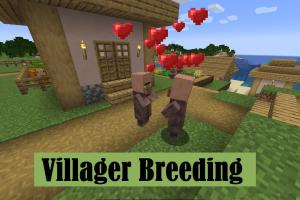Mastering Villager Breeding in Minecraft: A Comprehensive Guide

-
Quick Links:
- Introduction
- Understanding Villagers
- Preparing for Breeding
- Breeding Process
- Post-Breeding Care
- Troubleshooting Breeding Issues
- Advanced Breeding Techniques
- Case Studies
- Conclusion
- FAQs
Introduction
In the world of Minecraft, villagers are more than just passive characters—they are essential for trade, farming, and even creating your own thriving community. Breeding villagers can significantly enhance your gameplay experience. This comprehensive guide will walk you through the entire process, ensuring you have all the knowledge you need to successfully breed villagers in Minecraft.
Understanding Villagers
Villagers in Minecraft are NPCs (non-player characters) found in villages. They have various professions that allow them to trade items with players. Understanding their behavior is critical when planning to breed them.
Types of Villagers
- Farmer: Grows crops and trades food items.
- Librarian: Trades books and enchanted items.
- Blacksmith: Offers tools and armor.
- Cleric: Trades potions and rare items.
Villager Professions
Each villager has a profession that defines their trades. Understanding these professions can help you set up a thriving economy in your Minecraft world.
Preparing for Breeding
Before you can breed villagers, you need to prepare the environment and gather the necessary resources.
Building a Breeding Area
The first step in breeding villagers is creating a suitable environment. Here’s what to consider:
- Space: Ensure there is enough space—at least 3 blocks high and 2 blocks wide.
- Lighting: Use torches or glowstone to keep the area well-lit.
- Doors: Villagers need access to doors to feel secure.
Gathering Resources
You will need:
- Food: Bread (3 loaves per villager) or other food items.
- Doors: At least 3 doors to create a breeding environment.
- Villagers: You need at least two villagers to start breeding.
Breeding Process
Now that you are prepared, it’s time to begin the breeding process.
Step-by-Step Breeding Guide
- Place Doors: Ensure you have at least three doors in the breeding area.
- Feed the Villagers: Right-click on the villagers with bread or food items.
- Wait for Hearts: If successful, hearts will appear over their heads, indicating they are ready to breed.
- New Villager: After a short wait, a new baby villager will spawn.
Post-Breeding Care
After breeding, it’s essential to ensure the well-being of the new villagers.
Protecting the New Villager
Keep the area secure from hostile mobs. Use fences or walls to create a safe environment.
Feeding and Growing
Baby villagers will grow into adults in 20 minutes. Ensure they have access to food and beds to thrive.
Troubleshooting Breeding Issues
Sometimes, the breeding process may not go as planned. Here are common issues and their solutions:
Common Issues
- Villagers Not Breeding: Ensure they have enough food and doors.
- Too Many Villagers: Limit the number of villagers if the area becomes overcrowded.
Advanced Breeding Techniques
Once you master the basics, consider these advanced techniques to optimize your village:
Using Zombie Villagers
Transforming zombie villagers into regular villagers can expand your population. Use a splash potion of weakness and a golden apple to cure them.
Creating a Trading Hall
Organize your villagers by profession in a trading hall to maximize trading efficiency.
Case Studies
Let’s take a look at some successful villager breeding projects from the Minecraft community.
Case Study 1: The Efficient Trading Hall
A player built a trading hall with 20 villagers, each specializing in different trades, leading to an increase in resource availability.
Case Study 2: The Self-Sustaining Farm
A group of players created a self-sustaining farm using villagers, producing food and resources without player intervention.
Conclusion
Breeding villagers in Minecraft can enhance your gameplay experience, allowing you to create a thriving economy and community. By following the steps outlined in this guide, you can ensure successful breeding and management of villagers in your Minecraft world.
FAQs
1. Can I breed villagers without doors?
No, doors are essential for villagers to feel secure and initiate breeding.
2. What food do villagers need to breed?
Villagers require bread, carrots, potatoes, or beetroots to breed.
3. How long do baby villagers take to grow?
Baby villagers take about 20 minutes to grow into adults.
4. Can I breed villagers in survival mode?
Yes, breeding villagers is possible in both survival and creative modes.
5. Do villagers need to be of different professions to breed?
No, villagers can breed regardless of their professions.
6. How many villagers can I breed at once?
You can breed as many villagers as you have food and space for.
7. What should I do if my villagers stop breeding?
Ensure they have enough food, doors, and a secure environment.
8. Can villagers breed at night?
Yes, villagers can breed at night as long as they are safe and have enough food.
9. How do I cure a zombie villager?
Cure a zombie villager using a splash potion of weakness and a golden apple.
10. Can villagers breed in a confined space?
Villagers need enough space to move around; too confined a space may prevent breeding.
For further information, you can refer to these authoritative sources:
Random Reads
- How to get charmander in pokemon emerald
- How to change chrome icon
- How to change clothes dryer belt
- Remove oil from hardwood floor
- Remove pages from pdf
- How to get local channels on roku
- How to get lugia in pokemon gold
- How to make a digital clock
- How to make a bucket in minecraft
- How to make a pickaxe in minecraft